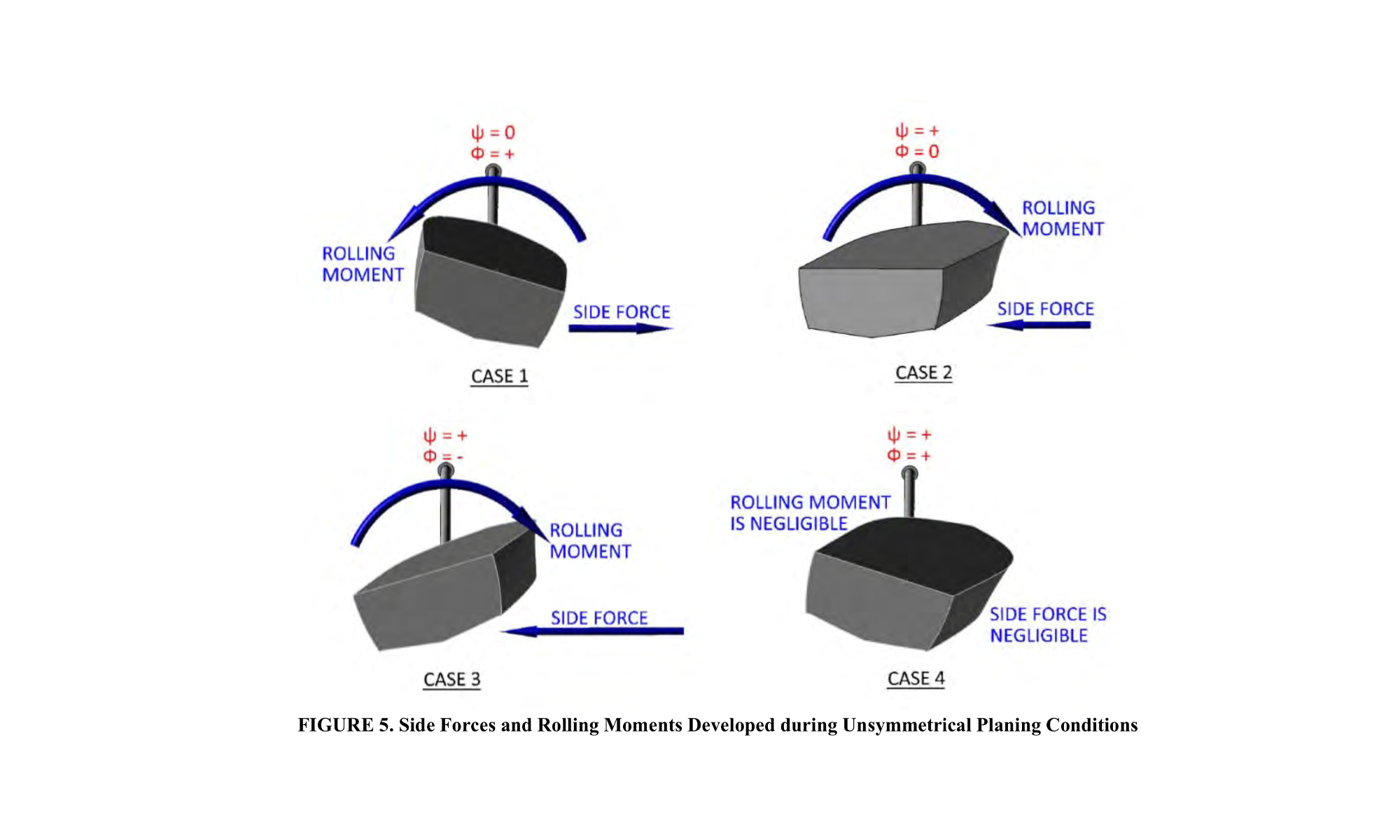DLBA UNIVERSITY
Turning Characteristics and Capabilities of High-Speed Monohulls
JUNE 28, 2020
By Jeffrey Bowles
The turning characteristics and capabilities of displacement vessels are well understood and
documented. Standards for the maneuvering capability of displacement vessels exist. However, the same information regarding high speed craft is not so readily available. Most documents in the public domain contain information on what high speed craft shouldn’t be able to do, not what they should be able to do.

This paper examines various aspects of the turning capabilities and characteristics of high speed monohull craft with regard to typical behavior and what type of maneuvering performance should be achievable. The dynamics, characteristics, and relationships of a hard chine monohull in a high speed turn are investigated and summarized.
The execution of high speed turns on hard chine monohulls can sometimes lead to unexpected
responses. This paper identifies several of the typical symptoms. The severity of these events will be discussed, and typical causes are identified. Notional maneuvering criteria are also proposed.
In case you would like to receive the full paper, or discuss about this subject, please contact Jeffrey Bowles.
References
1. Blount, D.L., Grossi L., and Lauro, G., “Sea Trials and Model-Ship Correlation of The High Speed gas Turbine Vessel DESTRIERO,” ASNE High
Performance Marine Vehicles Conference, Arlington, Virginia, 1992.
2. Daidola, J.C., Lundy, W., and Darr, R., “Evolution of the IMO Standards for Maneuverability,” SNAME Transactions, Vol. 110, 2002.
3. Deakin, B., “Model Tests to Assess the Maneuvering of Planing Craft,” The International HISWA Symposium on Yacht Design and Yacht
Construction, 2009.
4. Denny, S. B., and Hubble, E. N., “Prediction of Craft Turning Characteristics,” SNAME Hampton Roads Section Meeting, Jan 1991.
5. Gore, J. L., Et al., “Advanced Naval Vehicles Concepts Evaluation – Planing Vehicle Technical Assessment,” David Taylor Naval Ship Research
and Development Center, Report No. SDD-114-24, 1976. Page 18 of 18
6. Gray, W.O., Et al., “Channel Design and Vessel Maneuverability – Next Steps,” SNAME New York Metropolitan Section Meeting, 2002.
7. Hatch, G., “Performance and Hull Form of Fast Planing Craft,” Ship and Boat Builder, 1963.
8. Hsu, C.C., “On the Motions of High Speed Planing Craft,” Hydronautics, Technical Report No. 603-1, 1967.
9. Kennard, E., and Leibowitz, R.C., “Theory of forces and moments on Rudders as Affected by Ship Turning, Steady Change of Rudder Angle,
and Propeller Race,” Naval Ship Research and Development Center, Report 3246, 1970.
10. Landsburg, A.C., et al., “Design and Verification for Adequate Ship Maneuverability,” SNAME Transactions, Vol. 91, 1983.
11. Lewandowski, E., “An Examination of Roll-Yaw-Pitch Coupling of High Speed Planing Craft,” Small Boats Symposium, Norfolk, Virginia, 1993.
12. Lewandowski, E., “Trajectory Predictions for High Speed Planning Craft,” International Shipbuilding Progress 41 , No. 426, 1994.
13. Lewandowski, E.M., “Free Running Model Turning Tests of the U.S. Coast Guard 47 FT Motor Life Boat,” U.S. Coast Guard Report No. CG-D-
06-95, 1995.
14. Lewandowski, E.M. and Klosinski, W. E., “Rotating Arm Captive Model Tests of the U.S. Coast Guard Prototype 47 FT Motor Lifeboat,” U.S.
Coast Guard Report No. CG-D-30-98, 1998.
15. Lewandowski, E. M., The Dynamics Of Marine Craft – Maneuvering And Seakeeping, Advances Series on Ocean Engineering, Volume 22,
World Scientific, 2004.
16. Martin, L.L., “Maximum Feasible Rates of Turn of Naval Ships,” Admiralty Experiment Works Technical Report 76008, 1976.
17. Ranzenbach, R., and Bowles, J. “Development of an Emergency Trip System in Response to a Ride Control System FMEA,” 11th International
Conference on Fast Sea Transportation, Hawaii, USA, 2011.
18. Spangler, P.K., “Roll Motion Investigation of the 36-Foot Hydrographic Survey Launch,” NAVSEACOMBATSYSENGSTA Report No. 60-145,
1983.
19. Savitsky, D., Prowse, R.E., and Lueders, D.H., “High Speed Hydrodynamic Characteristics of a Flat Plate and 20° Deadrise Surface in
Unsymmetrical Planing Conditions,” NACA Technical Note 4187, 1958.
20. Savitsky, D., Roper, J., and Benen, L., “Hydrodynamic Development of a High Speed Planing Hull for Rough Water,” Ninth Symposium on
Naval Hydrodynamics, Vol. 1, France, 1972.
21. Sugai, K., “On the Maneuverability of the High Speed Boat,” Transportation Technical Research Institute, Ministry of Transportation, 1-1057,
Meijiro-cho, Toshina-ku, Tokyo, Vol. 12, No. 11, 1963.
22. Wakeling, B.P., Sproston, J.L., A. Millward, “Transverse Stability of a Fast Round Bilge Hull,” International Conference on Design
Considerations for Small Craft, February, 1984.
23. INTERNATIONAL CODE OF SAFETY FOR HIGH SPEED CRAFT, 2000, International Maritime Organization, 2008.
24. GUIDE FOR BUILDING AND CLASSING HIGH SPEED CRAFT, American Bureau of Shipping, 2012.
25. RULES FOR CLASSIFICATION OF HIGH SPEED, LIGHT CRAFT, AND NAVAL SURFACE CRAFT, Det Norske Veritas, 2008.
26. “Humphree CTOS,” HUMPHREE, n.d., http://www.humphree.com/products/boat-control-system/ctos-controlled-turnoptimisation-system/,
1 March 2012.
Share this article online:
HOW CAN WE HELP YOU?
FEEL FREE TO CONTACT US

DLBA Naval Architects
860 Greenbrier Circle, Suite 201 Chesapeake, Virginia 23320 USA
Phone: 757-545-3700 | Fax: 757-545-8227 | dlba@gibbscox.com
STAY UPDATED
SIGN UP FOR OUR NEWSLETTER
Keep your finger on the pulse of the latest points of focus in naval architecture and engineering: subscribe to DLBA’s concise monthly newsletter. Within it, we briefly describe and picture our latest projects and concepts. We encourage feedback and seek to have our newsletter spark conversation regarding potential collaborations and further advancements as we share our passion for the industry.
